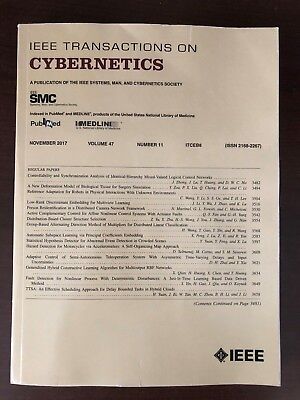Design and Pipeline Tracking Control of an Underwater Biomimetic Vehicle-Manipulator System With Hybrid Propulsion
IF 10.5
1区 计算机科学
Q1 AUTOMATION & CONTROL SYSTEMS
引用次数: 0
Abstract
Underwater vehicle-manipulator systems (UVMSs) play crucial roles in the fields of underwater target monitoring and pipeline maintenance. However, achieving accurate tracking for underwater pipelines is challenging due to the complexity of UVMSs in terms of nonlinearity, strong coupling and underactuation. To solve the aforementioned problems, an underwater biomimetic vehicle-manipulator system (UBVMS) and an underwater pipeline tracking control method based on the robot vision are proposed. The UBVMS is equipped with the biomimetic undulatory fin propulsors and the biomimetic flipper propulsors, which are inspired by the median and/or paired fin propulsion mode and the body and/or caudal fin propulsion mode of fishes, respectively. The biomimetic undulatory fin propulsors provide the UBVMS with advantages of maneuverability and stability, while the biomimetic flipper propulsors enable the UBVMS to have improved acceleration ability. A tracking control algorithm with adaptive weight coefficients is designed to improve the pose stability of the UBVMS. A fuzzy rule mapping model is constructed to describe the nonlinear relationship between the biomimetic propulsors’ control parameters and the propulsive force/torque. Finally, four types of pipeline tracking experiments are conducted to verify the effectiveness and feasibility of the proposed UBVMS and control algorithm.混合推进水下仿生机器人系统的设计与管道跟踪控制
水下航行器-操纵器系统在水下目标监测和管道维护领域发挥着至关重要的作用。然而,由于uvms在非线性、强耦合和欠驱动方面的复杂性,实现水下管道的精确跟踪是具有挑战性的。针对上述问题,提出了一种水下仿生机器人-机械手系统(UBVMS)和一种基于机器人视觉的水下管道跟踪控制方法。uvms配备仿生波动鳍推进器和仿生鳍推进器,这两种推进器分别受到鱼类中鳍和/或成对鳍推进模式和身体鳍和/或尾鳍推进模式的启发。仿生波动鳍形推进器为UBVMS提供了机动性和稳定性的优势,而仿生鳍形推进器则提高了UBVMS的加速能力。为了提高UBVMS的位姿稳定性,设计了一种自适应权系数跟踪控制算法。建立了模糊规则映射模型来描述仿生推进器控制参数与推进力/力矩之间的非线性关系。最后,进行了四种类型的管道跟踪实验,验证了所提出的UBVMS及其控制算法的有效性和可行性。
本文章由计算机程序翻译,如有差异,请以英文原文为准。
求助全文
约1分钟内获得全文
求助全文
来源期刊

IEEE Transactions on Cybernetics
COMPUTER SCIENCE, ARTIFICIAL INTELLIGENCE-COMPUTER SCIENCE, CYBERNETICS
CiteScore
25.40
自引率
11.00%
发文量
1869
期刊介绍:
The scope of the IEEE Transactions on Cybernetics includes computational approaches to the field of cybernetics. Specifically, the transactions welcomes papers on communication and control across machines or machine, human, and organizations. The scope includes such areas as computational intelligence, computer vision, neural networks, genetic algorithms, machine learning, fuzzy systems, cognitive systems, decision making, and robotics, to the extent that they contribute to the theme of cybernetics or demonstrate an application of cybernetics principles.
 求助内容:
求助内容: 应助结果提醒方式:
应助结果提醒方式:


